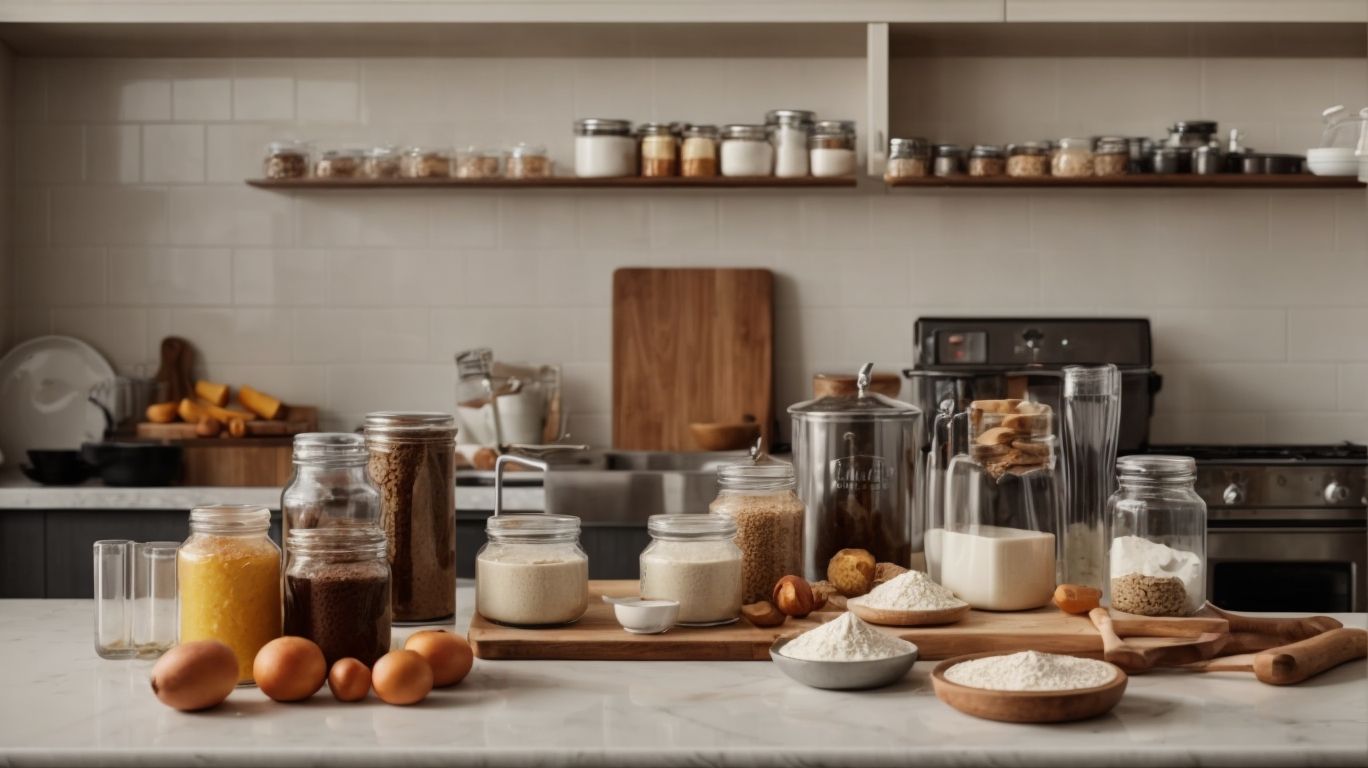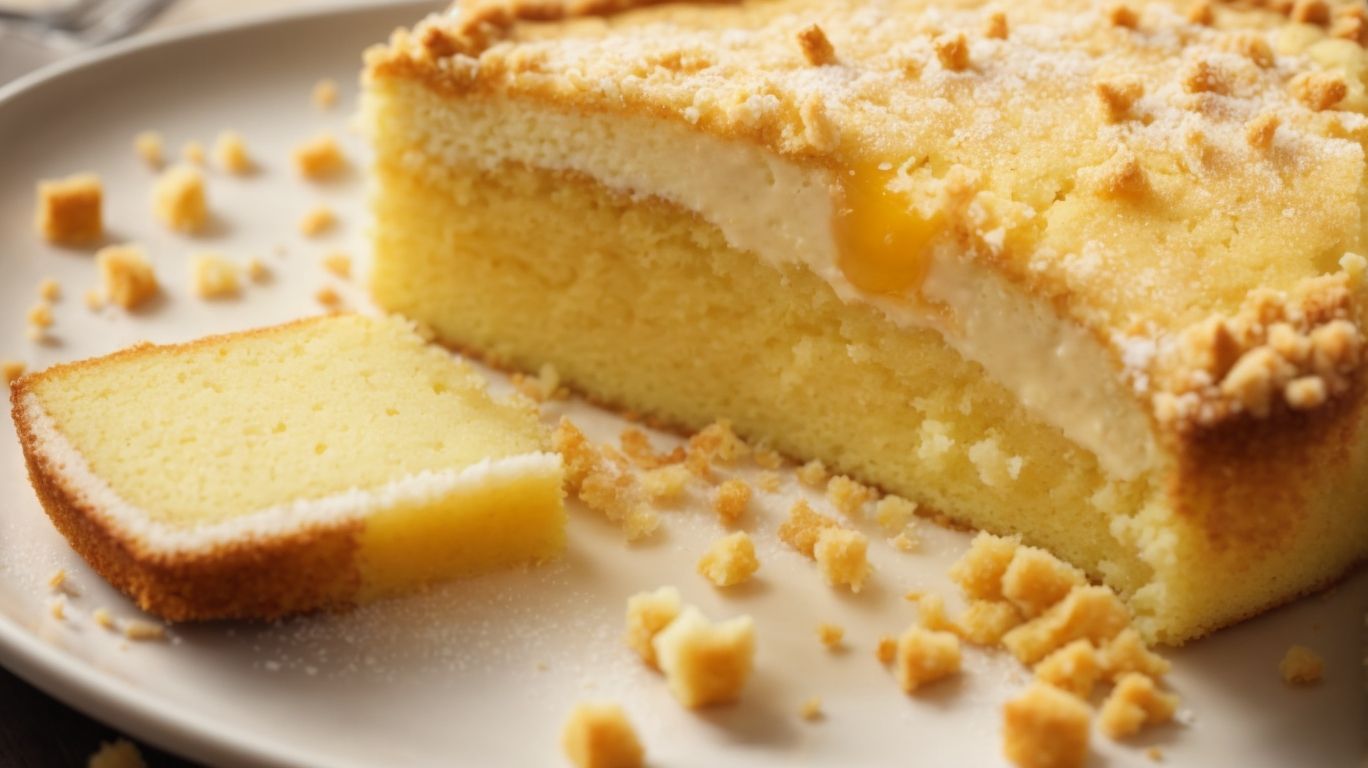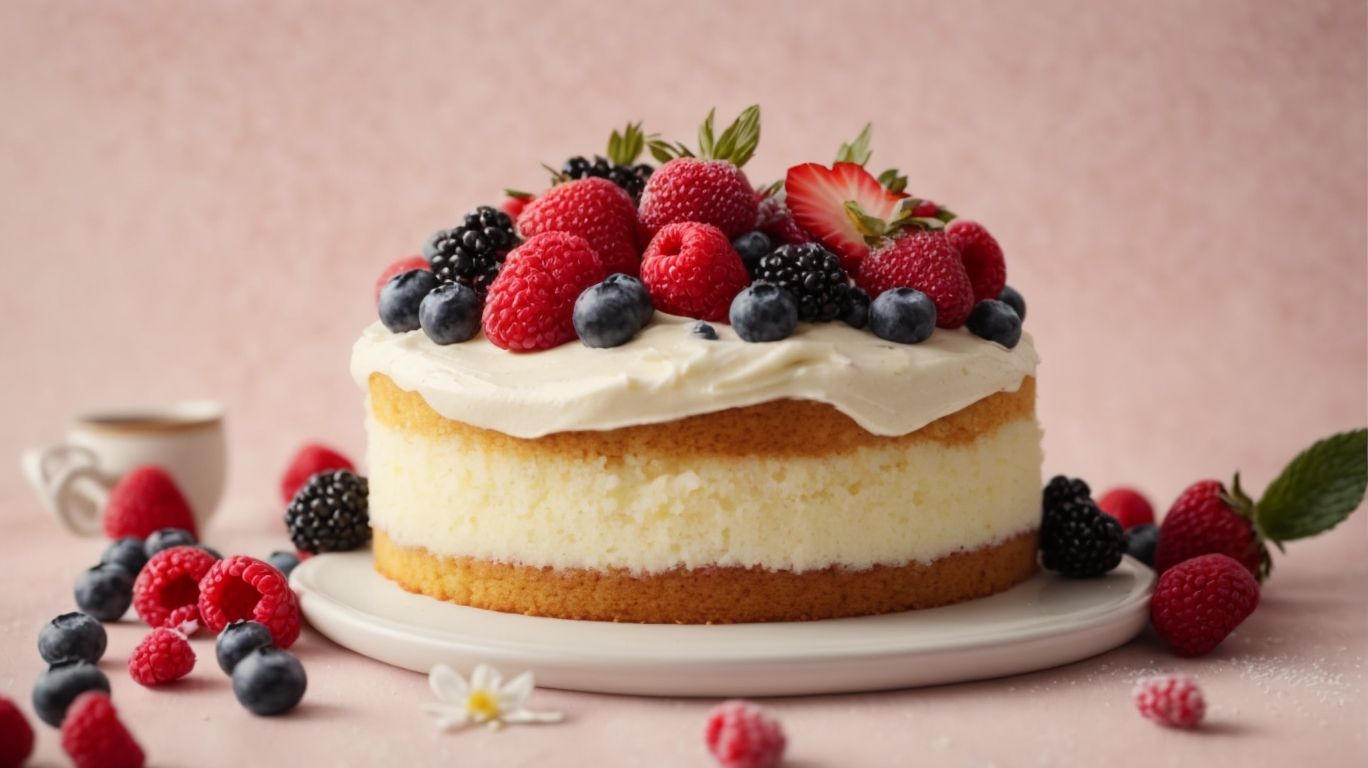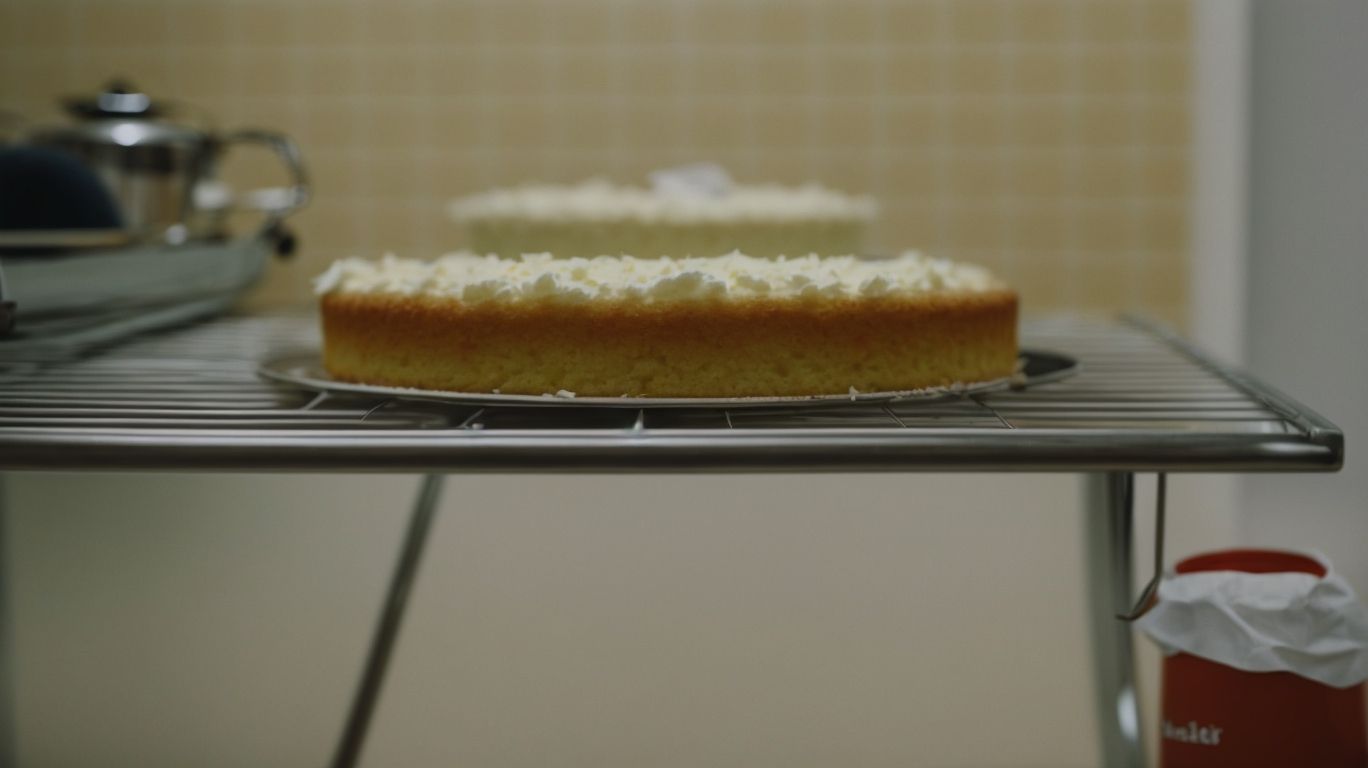How to Bake Vanilla Sponge Cake?
Are you looking to impress your guests with a delicious and light dessert? Look no further!
In this article, we will explore the world of vanilla sponge cake and learn how to bake it to perfection. From the essential ingredients to the step-by-step preparation and baking process, Chris Poormet will guide you through each stage.
Stay tuned as we delve into the art of creating a mouthwatering vanilla sponge cake that will surely wow your friends and family.
Key Takeaways:
About the Author: Chris Poormet

Credits: Poormet.Com – Anthony Baker
Chris Poormet, the owner of Poormet.com, is a renowned culinary blogger who clinched the prestigious title of Culinary Blogger of the Year. With a background as a celebrated chef excelling in food photography, Chris has amassed a dedicated following.
His blog, Poormet.com, serves as a hub for food enthusiasts, offering a treasure trove of delectable recipes, insightful culinary tips, and captivating food stories. Chris’s innovative approach to blending flavors and his eye for visually appealing food presentations have set him apart in the culinary world. Through his expertise in food photography, Chris manages to capture the essence of each dish, enticing his audience with vibrant and mouth-watering images. This unique combination of culinary mastery and visual storytelling has propelled Chris to the forefront of the food blogging sphere.
What Is Vanilla Sponge Cake?
Vanilla Sponge Cake is a delectable dessert known for its airy, moist, and soft texture. This classic sponge cake is infused with the rich flavor of vanilla, offering a delightful combination of lightness and sweetness.
The key to achieving the fluffy and light consistency of a Vanilla Sponge Cake lies in the mixing method; gently folding in the flour and ensuring not to deflate the air bubbles is crucial. This results in a cake that is soft to the touch and melts in your mouth with each bite. The moist nature of this cake is often enhanced by brushing the layers with a simple syrup to lock in moisture and add a subtle sweetness. Given its versatility, it serves as a base for various decorations, fillings, and frostings, making it a go-to choice for celebrations and gatherings.
What Are the Ingredients for Vanilla Sponge Cake?
The essential ingredients for preparing a delightful Vanilla Sponge Cake include eggs, sugar, butter, flour, baking powder, milk, and the aromatic essence of vanilla extract. Each component plays a crucial role in achieving the perfect balance of flavors and textures in this classic cake recipe.
Starting with eggs, they provide structure and stability to the cake batter, leading to a light and airy consistency when baked. The sugar not only sweetens the cake but also helps with moisture retention and creating a tender crumb.
Next, butter adds richness and flavor, contributing to the overall decadence of the cake. Flour acts as the base, providing the necessary bulk and structure.
Baking powder is the leavening agent that helps the cake rise and become fluffy. Milk adds a touch of moisture and tenderness to the sponge.
The vanilla extract enhances the aroma and flavor, giving the cake its signature taste.
Flour
Flour serves as the foundational element in Vanilla Sponge Cake, with cake flour being preferred due to its lower protein content and gluten levels. The use of high-quality Winter wheat ensures the desired texture and crumb structure in the cake.
Cake flour, unlike all-purpose flour, has a lower protein content, which results in a more delicate and tender cake. This is due to the fact that lower protein levels limit gluten formation, preventing the cake from becoming tough or chewy. Winter wheat, known for its higher amylase enzyme activity, aids in creating a lighter texture while retaining moisture in the cake, making it ideal for delicate bakes like sponge cakes. By choosing the right flour and wheat variety, bakers can achieve a soft, fluffy, and perfectly textured Vanilla Sponge Cake.
Sugar
Sugar acts as the primary sweetener in Vanilla Sponge Cake, providing the necessary sweetness and contributing to the cake’s texture and tenderness. When caramelized during baking, sugar enhances the flavor profile of the cake.
Granulated sugar is the commonly used form of sugar in Vanilla Sponge Cake, ensuring the right balance of sweetness without overpowering the other flavors. The caramelization process is crucial as it transforms the sugar into a rich, complex flavor that adds depth and a beautiful golden color to the cake. It also aids in creating a slightly crispy crust on the outer edges, offering a delightful contrast to the soft crumb inside.
Eggs
Eggs play a crucial role in Vanilla Sponge Cake, contributing to both the leavening and structural integrity of the cake. The separation of egg whites and yolks allows for a light and fluffy texture in the final product.
When eggs are added to the cake batter, the proteins in the egg whites help create a stable foam structure that traps air bubbles during mixing. This trapped air expands in the oven due to the heat, causing the cake to rise. Egg yolks contain emulsifiers and fats that add richness and moisture to the cake, enhancing its flavor and texture. Separating the eggs and whipping the whites separately helps achieve an airy and delicate crumb in the sponge cake, making it a favorite among baking enthusiasts.
Butter
Butter, a staple in Western cakes, plays a vital role in Vanilla Sponge Cake by adding richness and flavor. Creaming butter creates a light and airy base, while the fat content contributes to the cake’s moisture and tenderness.
The incorporation of butter in Vanilla Sponge Cake not only affects the texture but also enhances the overall taste profile. The creamy richness that butter brings is irreplaceable, giving the cake a melt-in-your-mouth quality that is highly desirable. The fat content in butter also aids in retaining moisture, preventing the cake from drying out during baking. Butter helps in creating a tender crumb structure, making each bite soft and delectable.
Vanilla Extract
Vanilla Extract imparts a delightful flavor and aroma to Vanilla Sponge Cake, enhancing its overall essence. The use of high-quality Queen Vanilla Extract ensures a rich and authentic vanilla taste in the cake.
Queen Vanilla Extract, sourced from premium vanilla beans, adds a depth of flavor that elevates the taste profile of the cake. Its robust aroma permeates through the sponge, creating a sensory delight for vanilla enthusiasts. The essence of Queen Vanilla Extract lies in its natural extraction process, preserving the purest form of vanilla essence, free from artificial additives or flavors. Incorporating this high-quality extract enhances the overall baking experience, resulting in a moist, flavorful, and irresistible Vanilla Sponge Cake.
Baking Powder
Baking Powder acts as a leavening agent in Vanilla Sponge Cake, triggering a chemical reaction that results in a light and fluffy crumb texture. The precise measurement and incorporation of baking powder are critical for achieving the desired rise in the cake.
When mixed with wet ingredients, baking powder releases carbon dioxide gas bubbles through a reaction between an acid (often cream of tartar) and a base (usually baking soda). This gas expands the air pockets in the batter, causing the cake to rise during baking. The timing of this reaction is crucial because if the cake sits too long before baking, the leavening effect may diminish.
Milk
Milk serves as a vital liquid component in Vanilla Sponge Cake, contributing to its moistness and aiding in the formation of a smooth batter. The inclusion of dairy milk enhances the overall richness and tenderness of the cake.
The fat content in milk plays a crucial role in providing structure and richness to the cake, resulting in a velvety texture. When mixed with the other ingredients, milk helps create a homogeneous mixture that ensures an even distribution of flavors throughout the cake. The proteins in milk aid in binding the ingredients together, giving the cake its desired structure and soft crumb. The presence of milk in Vanilla Sponge Cake not only adds nutritional value but also contributes to its delightful taste and texture.
How to Prepare the Ingredients?

Credits: Poormet.Com – Vincent Nguyen
To create a perfect Vanilla Sponge Cake, meticulous preparation of the ingredients is crucial. Follow these step-by-step instructions to ensure each component is ready for the baking process.
Start by gathering all the necessary ingredients, including flour, sugar, eggs, vanilla extract, and baking powder.
Ensure that the eggs are at room temperature to achieve the desired texture. Separate the egg yolks from the whites, as they will be beaten separately to incorporate air into the batter.
Sift the flour to remove any lumps and aerate it for a lighter cake. Cream the butter and sugar until light and fluffy, creating a smooth base for the batter.
Preheat the Oven
The initial step in preparing for Vanilla Sponge Cake is to preheat the oven to the required temperature. Setting the oven correctly ensures an optimal baking environment for the cake batter.
Temperature control during baking is crucial as it directly affects the texture, rise, and overall success of the cake. When the oven is preheated to the specified temperature, it allows the batter to start cooking immediately upon entering the oven, leading to proper rise and aeration. Consistency in temperature throughout the baking process ensures even cooking and prevents uneven browning. This precision in heat management also helps in achieving the desired moistness and tenderness in the sponge cake texture.
Sift the Flour and Baking Powder
Sifting the Flour and Baking Powder together is a critical step in preparing a smooth and lump-free dry mixture for Vanilla Sponge Cake.
This process ensures that the dry ingredients are evenly distributed and properly incorporated, leading to a consistent texture in the final cake.
- By passing the flour and baking powder through a sieve or flour sifter, any lumps or clumps are broken up and aerated, resulting in a light and airy batter.
- It’s essential to achieve a uniform consistency, as any pockets of unmixed ingredients can disrupt the rise and structure of the cake during baking.
Cream the Butter and Sugar
{
Creaming the Butter and Sugar together is a fundamental step in creating a light and airy base for Vanilla Sponge Cake. This process involves thorough mixing to achieve a smooth and creamy consistency. The creaming method is crucial as it incorporates air into the mixture, resulting in a light and fluffy texture in the final cake. When the butter and sugar are creamed properly, it helps trap air bubbles which expand during baking, contributing to the cake’s rise. Achieving the right texture requires patience and attention to detail, ensuring the ingredients are fully combined and no lumps remain.”
}
Creaming the Butter and Sugar together is a fundamental step in creating a light and airy base for Vanilla Sponge Cake. This process involves thorough mixing to achieve a smooth and creamy consistency. The creaming method is crucial as it incorporates air into the mixture, resulting in a light and fluffy texture in the final cake. When the butter and sugar are creamed properly, it helps trap air bubbles which expand during baking, contributing to the cake’s rise. Achieving the right texture requires patience and attention to detail, ensuring the ingredients are fully combined and no lumps remain.
Add in the Eggs and Vanilla Extract
Incorporating the Eggs and Vanilla Extract into the butter-sugar mixture adds richness and flavor to Vanilla Sponge Cake.
When adding Eggs to the batter, it’s crucial to do so one at a time, ensuring each egg is fully incorporated before adding the next. This process helps prevent curdling and ensures a smooth, consistent texture.
For the Vanilla Extract, a high-quality, pure extract is recommended for the best flavor. Add it gradually while mixing to evenly distribute the vanilla essence throughout the batter, enhancing the overall taste.
Proper mixing techniques involve gently folding the wet and dry ingredients together until just combined. Overmixing can lead to a dense cake, so it’s important to stop as soon as the ingredients are evenly blended.
Alternate Adding Flour and Milk
An essential step in creating the batter for Vanilla Sponge Cake is to alternately add Flour and Milk while mixing. This gradual incorporation method ensures a smooth and well-blended batter.
As you start the process, begin by sifting the Flour to remove any lumps for a lighter texture. Slowly add a portion of the Flour into the mixing bowl containing the other ingredients, then gently fold in before incorporating a portion of Milk.
Each addition should be carefully mixed until just combined; overmixing can lead to a dense and tough cake. Aim for a batter that is smooth and homogeneous, with no streaks of flour visible.
Continue this alternating process until all the Flour and Milk have been added, ending with the final addition of Flour.
How to Bake the Vanilla Sponge Cake?

Credits: Poormet.Com – Lawrence Carter
Baking the Vanilla Sponge Cake to perfection requires attention to detail and precision in the baking process. Follow these steps to ensure your cake turns out light, fluffy, and delicious.
To start, preheat your oven to 350°F (180°C) and ensure your baking rack is placed in the center of the oven for even heat distribution. Grease your cake pans with butter and dust them with flour to prevent the cake from sticking. In a mixing bowl, cream together softened butter and sugar until light and fluffy. Add in eggs one at a time, incorporating each fully before adding the next.
Sift cake flour, baking powder, and a pinch of salt into the wet ingredients. Gently fold the dry ingredients into the wet mixture until just combined. Overmixing can result in a dense cake texture, so be careful not to overdo it.
Grease and Flour the Cake Pan
Preparing the Cake Pan by greasing and flouring it is essential to prevent the cake from sticking and ensure easy removal after baking. This step sets the foundation for a well-formed Vanilla Sponge Cake.
Greasing the pan involves applying a thin layer of butter or oil on all inner surfaces of the pan using a pastry brush or paper towel. This ensures that the cake does not adhere to the pan while baking.
Flouring the pan comes next, where a small amount of flour is dusted onto the greased surface, creating a non-stick barrier between the batter and the pan. It helps in smooth release of the cake once it’s baked, preserving its shape and texture.
Pour the Batter into the Pan
Once the batter for Vanilla Sponge Cake is ready, carefully pour it into the prepared Cake Pan. Ensuring an even and smooth distribution of the batter sets the stage for uniform baking results.
When pouring the batter into the Cake Pan, make sure to slowly pour it from the center, allowing it to naturally spread towards the edges. You can gently shake the pan side to side to help level the surface*. It’s crucial to use a spatula to scrape off any excess batter from the mixing bowl to achieve an even layer.
To ensure consistent baking, avoid overfilling the pan; it should only be filled up to two-thirds of its total capacity. The batter should be evenly spread using a back-and-forth motion to maintain a level surface for the cake to rise uniformly during baking.
Bake the Cake for 30-35 Minutes
Baking the Vanilla Sponge Cake in the preheated oven for 30-35 minutes is crucial for achieving the perfect texture and flavor. Monitor the baking process to ensure the cake is light, fluffy, and golden brown.
When baking the Vanilla Sponge Cake, it’s essential to preheat the oven properly to ensure even cooking. The temperature should be set around 350°F (180°C) for optimal results. The typical baking time of 30-35 minutes may vary slightly depending on the oven’s accuracy, so always rely on visual cues. As the cake bakes, you’ll notice it rising and starting to turn a beautiful golden hue. To double-check doneness, insert a toothpick into the center; if it comes out clean, the cake is ready to be removed from the oven.
How to Decorate and Serve the Vanilla Sponge Cake?

Credits: Poormet.Com – Kenneth Harris
Enhancing the presentation of Vanilla Sponge Cake through decorative elements and thoughtful serving techniques adds to the overall appeal of this delectable dessert. Follow these steps to create a visually stunning and delicious cake.
Regarding frosting options for your Vanilla Sponge Cake, the classic buttercream frosting is always a crowd-pleaser with its creamy texture and sweet taste. Alternatively, consider a whipped cream frosting for a lighter touch or a cream cheese frosting for a tangy contrast. To further elevate the visual appeal, try incorporating fresh berries, edible flowers, or chocolate shavings as decorative enhancements. These additions not only add color and texture but also introduce complementary flavors that harmonize with the cake. When serving, opt for elegant cake stands or serving platters to showcase your masterpiece. Remember, the presentation is just as important as the taste, so let your creativity flourish and delight your guests with a beautifully decorated Vanilla Sponge Cake.
Let the Cake Cool
Allowing the Vanilla Sponge Cake to cool properly post-baking is essential before proceeding with frosting and serving. This cooling period ensures the cake sets and retains its moisture for a delightful eating experience.
Cooling the Vanilla Sponge Cake involves transferring it from the hot oven to a cooling rack, where it gradually reaches room temperature. This gradual cooling process prevents the cake from becoming overly dense or collapsing.
When the cake cools slowly, its internal structure stabilizes, resulting in a light and airy texture that complements the sweetness of the frosting. Allowing the cake to cool completely before frosting prevents the frosting from melting and sliding off, ensuring a visually appealing presentation and a satisfying taste with each bite.
Frost the Cake with Vanilla Buttercream
Frosting the Vanilla Sponge Cake with a luscious Vanilla Buttercream adds a creamy and flavorful finishing touch to the dessert. The smooth and rich buttercream complements the lightness of the cake.
Vanilla Buttercream, made with butter, powdered sugar, and vanilla extract, creates a decadent layer that envelopes each bite in a velvety embrace. This creamy concoction not only enhances the sweetness of the cake but also provides a luxurious mouthfeel that elevates the overall experience.
The process of evenly applying the buttercream onto the cake’s surface demands precision and finesse. Smooth, sweeping motions with a spatula ensure a flawless finish, creating a professional-looking dessert that promises a heavenly taste with every forkful.
Add Decorations and Serve
Elevate the visual appeal of Vanilla Sponge Cake by adding decorative elements and garnishes before serving. The artful presentation enhances the dining experience and showcases the beauty of the cake.
To achieve a visually stunning Vanilla Sponge Cake presentation, consider using fresh fruits like strawberries, blueberries, or kiwi slices as colorful toppings. Edible flowers such as pansies or roses add an elegant touch. Incorporating chocolate shavings, crushed nuts, or sprinkles can also bring texture and contrast to the cake’s appearance.
When placing the embellishments, aim for balance and symmetry to create a harmonious look. Dusting the cake with powdered sugar or cocoa powder through a stencil can introduce intricate designs. Experiment with different plating techniques such as using a pastry ring for a professional finish.
Frequently Asked Questions
How to Bake Vanilla Sponge Cake?
What ingredients do I need to bake a vanilla sponge cake?
You will need all-purpose flour, sugar, eggs, milk, vanilla extract, baking powder, and salt.
How to Bake Vanilla Sponge Cake?
Can I use a different type of flour for this recipe?
Yes, you can substitute all-purpose flour with cake flour for a lighter and fluffier texture.
How to Bake Vanilla Sponge Cake?
Do I need special equipment to make a vanilla sponge cake?
No, you just need a mixing bowl, hand or stand mixer, and a 9-inch round cake pan.
How to Bake Vanilla Sponge Cake?
How long does it take to bake a vanilla sponge cake?
It usually takes 25-30 minutes at 350°F, but the exact time may vary depending on your oven.
How to Bake Vanilla Sponge Cake?
Can I add any toppings or fillings to my vanilla sponge cake?
Yes, you can add fresh fruit, whipped cream, or jam in between the layers or on top of the cake for added flavor.
How to Bake Vanilla Sponge Cake?
Can I make this cake in advance and freeze it?
Yes, you can bake the cake and freeze it for up to 2 months. Just make sure to wrap it tightly with plastic wrap to prevent freezer burn.

